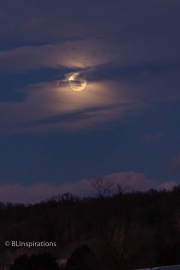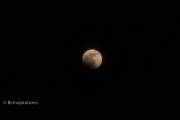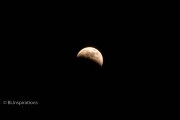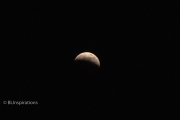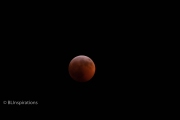by Laurie
In February 2021 I started going through my more recent photographs to see if everything had been imported into Lightroom. I found a lunar eclipse folder in which a few images had been imported, but the majority had not. I didn’t remember the eclipse until I reviewed the photos and researched the eclipse online.
This total lunar eclipse occurred on January 20, 2019. Earlier in the evening, there were clouds in the sky and I was worried that they would block the eclipse, but the sky cleared before the eclipse started. There is a picture of the full moon through the clouds and the progression of the moon toward the partial to total eclipse in the Additional Images gallery below. I read an account from one photographer who drove to North Carolina to photograph the eclipse because the weather forecast was cloudy for all of Virginia. Fortunately the clouds were gone when I took my eclipse photos. These photos were taken near our previous house in Lacey Spring, VA.
A total lunar eclipse occurs when there is a full moon and the Sun, the Earth, and the Moon are in perfect alignment so that the Earth blocks the Sun’s light from falling directly on the Moon. This is a diagram of a total lunar eclipse:

There are three possible lunar eclipse phases as the moon passes through the earth’s shadow – a total lunar eclipse will go through all three, in this order:
- A penumbral lunar eclipse occurs when only the more diffuse outer shadow of Earth – the penumbra (from the Latin paene “almost, nearly”) – falls on the moon’s face. This kind of lunar eclipse is much more subtle, and much more difficult to observe than either a total or partial eclipse of the moon. There is never a dark bite taken out of the moon, as in a partial eclipse. The eclipse never progresses to reach the dramatic minutes of totality. At best, at mid-eclipse, observant people will notice a dark shading on the moon’s face. Others will look and notice nothing at all.
- A partial lunar eclipse occurs when the earth’s shadow darkens only a part of the moon. The dark bite grows larger, and then recedes, never reaching the total phase.
- A total lunar eclipse occurs when the moon passes entirely through the dark, inner part of Earth’s shadow, the umbra (Latin for “Shadow”). During the total eclipse, the only light reaching the moon passes through the Earth’s atmosphere, which makes the Moon’s surface look red. This red appearance is the reason it is referred to as a ‘blood’ moon, a popular name for lunar eclipses.
The lunar eclipse on January 20, 2019 was called a Super Blood Wolf Moon:
- “Super” because when the moon is closest to the earth it appears about 14% larger than when it is farthest from the earth.
- “Blood” because during a total eclipse, the moon takes on a red hue.
- “Wolf” refers to the name give to the full moon in January. In the 1930s the Maine Farmer’s Almanac began publishing American Indian Moon names for the months of the year. According to this almanac, the name refers to the time when wolves would howl outside villages.
Eclipse Details:
The penumbral eclipse began at 9:36 PM, the partial eclipse began at 10:34 PM, and the total eclipse began at 11:41 PM. The total eclipse lasted until 12:43 AM (on January 21, 2019) and the penumbral eclipse ended at 2:48 AM.
Once the moon was in partial eclipse I started taking photographs using my 55-250mm f/4-5.6 telephoto zoom lens with the Kinko 1.4 teleconverter, which yields a focal length of 350mm. In the Additional Images gallery below I did not include any photos of the moon during the penumbra phase.
More Information:
Wikipedia: Lunar Eclipse
Space.com: Super Blood Wolf Moon Eclipse of 2019
UK Express: Eclipse 2019 in Virginia
Additional Images
Technical Data
January 20, 2019 Full Moon
- Date: 1/20/2019
- Time: 5:42 PM
- Camera: Canon EOS 77D
- Lens: Canon EF-S 55-250mm f/4-5.6 IS STM telephoto zoom lens
- Settings:
- Lens: 149 mm, f/5.0
- ISO: 800
- Shutter: 1/60 sec
- Uncropped image is 4000 x 6000 px
January 20, 2019 Lunar Eclipse 2
- Date: 1/20/2019
- Time: 10:54 PM
- Camera: Canon EOS 77D
- Lens: Canon EF-S 55-250mm f/4-5.6 IS STM telephoto zoom lens + Tokina 1.4 Teleconverer
- Settings:
- Lens: 350 mm, f/11
- ISO: 100
- Shutter: 1/80 sec
- Uncropped image is 6000 x 4000 px
January 20, 2019 Lunar Eclipse 4
- Date: 1/20/2019
- Time: 11:15 PM
- Camera: Canon EOS 77D
- Lens: Canon EF-S 55-250mm f/4-5.6 IS STM telephoto zoom lens + Tokina 1.4 Teleconverer
- Settings:
- Lens: 350 mm, f/11
- ISO: 1600
- Shutter: 1/500 sec
- Uncropped image is 6000 x 4000 px
January 20, 2019 Lunar Eclipse 1
- Date: 1/20/2019
- Time: 10:35 PM
- Camera: Canon EOS 77D
- Lens: Canon EF-S 55-250mm f/4-5.6 IS STM telephoto zoom lens
- Settings:
- Lens: 250 mm, f/11
- ISO: 800
- Shutter: 1/1250 sec
- Uncropped image is 6000 x 4000 px
January 20, 2019 Lunar Eclipse 3
- Date: 1/20/2019
- Time: 11:07 PM
- Camera: Canon EOS 77D
- Lens: Canon EF-S 55-250mm f/4-5.6 IS STM telephoto zoom lens + Tokina 1.4 Teleconverer
- Settings:
- Lens: 350 mm, f/11
- ISO: 400
- Shutter: 1/80 sec
- Uncropped image is 6000 x 4000 px
January 20, 2019 Super Blood Wolf Moon Lunar Eclipse
- Date: 1/20/2019
- Time: 11:50 PM
- Camera: Canon EOS 77D
- Lens: Canon EF-S 55-250mm f/4-5.6 IS STM telephoto zoom lens + Tokina 1.4 Teleconverer
- Settings:
- Lens: 350 mm, f/8.0
- ISO: 6400
- Shutter: ⅛ sec
- Uncropped image is 6000 x 4000 px

